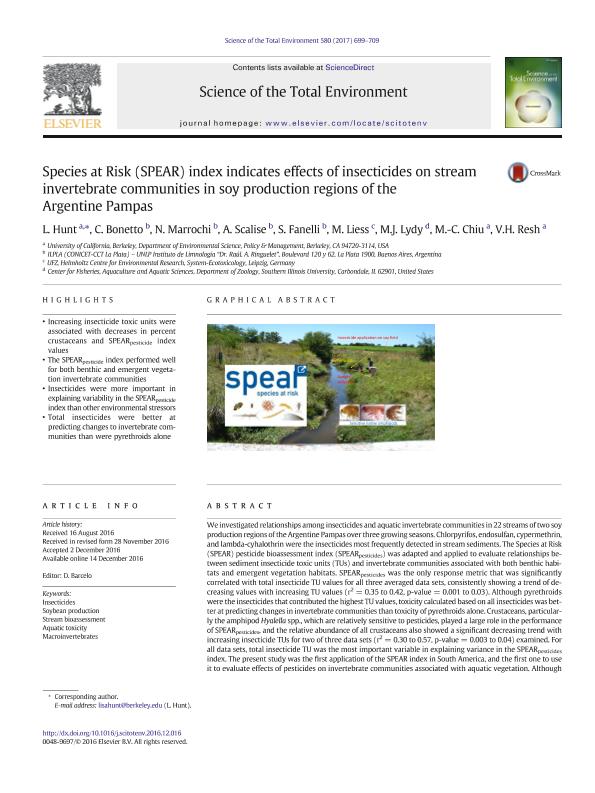Artículo
Species at Risk (SPEAR) index indicates effects of insecticides on stream invertebrate communities in soy production regions of the Argentine Pampas
Hunt, Lisa; Bonetto, Carlos Alberto ; Marrochi, María Natalia
; Marrochi, María Natalia ; Scalise, Ana Maria
; Scalise, Ana Maria ; Fanelli, Silvia Laura
; Fanelli, Silvia Laura ; Liess, M.; Lydy, Michael J.; Chiu, M. C.; Resh, Vincent H.
; Liess, M.; Lydy, Michael J.; Chiu, M. C.; Resh, Vincent H.
 ; Marrochi, María Natalia
; Marrochi, María Natalia ; Scalise, Ana Maria
; Scalise, Ana Maria ; Fanelli, Silvia Laura
; Fanelli, Silvia Laura ; Liess, M.; Lydy, Michael J.; Chiu, M. C.; Resh, Vincent H.
; Liess, M.; Lydy, Michael J.; Chiu, M. C.; Resh, Vincent H.
Fecha de publicación:
02/2017
Editorial:
Elsevier Science
Revista:
Science of the Total Environment
ISSN:
0048-9697
Idioma:
Inglés
Tipo de recurso:
Artículo publicado
Clasificación temática:
Resumen
We investigated relationships among insecticides and aquatic invertebrate communities in 22 streams of two soy production regions of the Argentine Pampas over three growing seasons. Chlorpyrifos, endosulfan, cypermethrin, and lambda-cyhalothrin were the insecticides most frequently detected in stream sediments. The Species at Risk (SPEAR) pesticide bioassessment index (SPEARpesticides) was adapted and applied to evaluate relationships between sediment insecticide toxic units (TUs) and invertebrate communities associated with both benthic habitats and emergent vegetation habitats. SPEARpesticides was the only response metric that was significantly correlated with total insecticide TU values for all three averaged data sets, consistently showing a trend of decreasing values with increasing TU values (r2 = 0.35 to 0.42, p-value = 0.001 to 0.03). Although pyrethroids were the insecticides that contributed the highest TU values, toxicity calculated based on all insecticides was better at predicting changes in invertebrate communities than toxicity of pyrethroids alone. Crustaceans, particularly the amphipod Hyalella spp., which are relatively sensitive to pesticides, played a large role in the performance of SPEARpesticides, and the relative abundance of all crustaceans also showed a significant decreasing trend with increasing insecticide TUs for two of three data sets (r2 = 0.30 to 0.57, p-value = 0.003 to 0.04) examined. For all data sets, total insecticide TU was the most important variable in explaining variance in the SPEARpesticides index. The present study was the first application of the SPEAR index in South America, and the first one to use it to evaluate effects of pesticides on invertebrate communities associated with aquatic vegetation. Although the SPEAR index was developed in Europe, it performed well in the Argentine Pampas with only minor modifications, and would likely improve in performance as more data are obtained on traits of South American taxa, such as pesticide sensitivity and generation time.
Archivos asociados
Licencia
Identificadores
Colecciones
Articulos(ILPLA)
Articulos de INST.DE LIMNOLOGIA "DR. RAUL A. RINGUELET"
Articulos de INST.DE LIMNOLOGIA "DR. RAUL A. RINGUELET"
Citación
Hunt, Lisa; Bonetto, Carlos Alberto; Marrochi, María Natalia; Scalise, Ana Maria; Fanelli, Silvia Laura; et al.; Species at Risk (SPEAR) index indicates effects of insecticides on stream invertebrate communities in soy production regions of the Argentine Pampas; Elsevier Science; Science of the Total Environment; 580; 2-2017; 699-709
Compartir
Altmétricas



